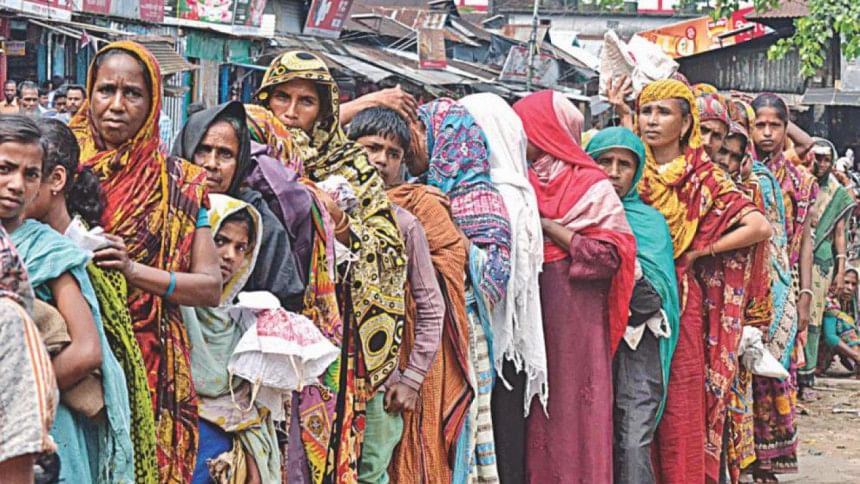Safety net spending to be higher

The budgetary allocation for safety net programmes would see a major uptick in the next fiscal year as the government looks to widen the number of beneficiaries struggling to make ends meet because of the coronavirus outbreak.
Finance Minister AHM Mustafa Kamal may set aside Tk 125,000 crore -- up more than 68 percent from Tk 74,367 crore in the current fiscal year -- for various safety net programmes while unveiling the budget for fiscal year 2020-21 on June 11, said a finance ministry official.
The allocation would be three percent of the gross domestic product (GDP), up from 2.58 percent in FY 2019-20.
Millions of people have lost their jobs owing to the countrywide shutdown enforced from March 26 to flatten the curve on the deadly virus.
Due to the income shock caused by the pandemic, 77.2 percent of the vulnerable non-poor fell below the poverty line, according to a joint survey of the Power and Participation Research Centre (PPRC) and the Brac Institute for Governance and Development.
This would imply that beyond the 20.5 percent of the population officially recognised as poor, there is a group of "new poor" representing an additional 22.9 percent of the population that needed to be brought within the discussion on poverty.
The situation prompted the government to beef up social safety net spending.
The allocation per beneficiary would not go up in terms of amount; rather, the number of beneficiaries would increase.
The government is boosting the allocation for eight core safety net programmes, especially those of food-based ones.
There are 81 lakh beneficiaries under the schemes and that number will rise by 10 lakh.
The number of widows, destitute and deserted women entitled to Tk 500 per month support from the government would increase by 8.5 lakh. Another 2.5 lakh would be added to the list of the financially insolvent disabled, who receive Tk 750 a month, said officials of the finance and social welfare ministries.
The number of beneficiaries receiving maternity allowance would go up by 10 percent. Currently, 750,000 individuals get such a payment. The increase in the number of beneficiaries would largely happen in 100 poverty-prone upazilas in northern and central districts under a government plan aiming to ensure 100 percent social safety net coverage from the current 40 percent, the officials said.
The government is aiming to spend a majority of the financial support coming from the development partners for the safety net purposes. The donors are also placing emphasis on expanding spending for the poor and the vulnerable.
"The increase was expected as many new poor have been created because of the coronavirus fallout," Hossain Zillur Rahman, executive chairman of the PPRC, told The Daily Star yesterday.
According to the economist, there are two aspects of the safety net programmes: one is allocation and the other is delivering the support to intended beneficiaries.
"The second aspect is very important because leakage is a major problem for us."
The ongoing safety net programmes should continue. At the same time, the government should step up to introduce schemes for the urban poor as most of the programmes target beneficiaries in the rural areas, he said.
Safety net programmes in Bangladesh have been contributing to the reduction of poverty and vulnerability by addressing a range of population groups through different forms of assistance, says the World Bank.
These include the provision of income security for the elderly, widows, and persons-with-disabilities, generating temporary employment for working age men and women, and supporting the healthy development of young mothers and children.


 For all latest news, follow The Daily Star's Google News channel.
For all latest news, follow The Daily Star's Google News channel. 



Comments